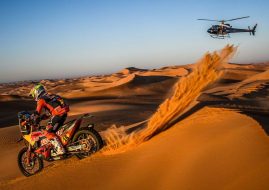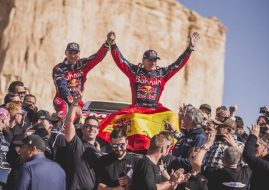History of Dakar Rally, one of the world's most iconic racing events
The Dakar Rally has always been one of the most popular races in history of motorsport, resonating with both the fans and drivers that place it in line with other iconic racing events, such as the 24 Hours of Le Mans, Indianapolis 500, Rallye Monte-Carlo and Formula One Monaco Grand Prix.
Dakar Rally – from Africa to South America
The event was first organized in 1978 as the Paris-Dakar Rally, because the start of the race was in France and finish was in Senegal. The French capital was a regular starting point until 1994. Since then, the routes were changed several times, so the event was commonly referred not as Paris-Dakar but just as The Dakar. In 2008, the event was cancelled due to security threats in Mauritania and from 2009, the Dakar Rally was held in South America.

Thierry Sabine had problems with a helicopter at the 1985 Dakar Rally. One year later, he died in a helicopter crash
70 deaths in 40 editions of the race
Although FIA has been organizing the Cross Country Rally World Cup since 1993, Dakar Rally was always a special event and was organized by a private firm named Amaury Sport Organisation (ASO). Compared to other cross country rally races, The Dakar is much longer and it is considered to be the most dangerous race in the world. Unfortunately, that title is a consequence of numerous deaths of competitors and spectators, as in 40 editions of the race, 70 persons were killed in various accidents.

Thierry Sabine, founder of the Dakar Rally, was killed in a helicopter crash during the 1986 race
Thierry Sabine got the Dakar idea while lost in the desert
It’s interesting that the founder of the Dakar Rally Thierry Sabine was also killed in an accident during the 1986 event. He was one of five victims of a helicopter crash during a sudden sand-storm in the African country of Mali.
Sabine’s idea of organizing the first Paris-Dakar Rally originated in 1977, when he was a participant of the Abidjan-Nice cross country race. He was lost in the Tenere Desert and concluded that this area could be perfect for organizing a new intercontinental race.

Thierry Sabine got an idea about desert race after he lost during the race in Tenere desert
182 bikes, trucks and cars in the first ever Paris – Dakar Rally
The first ever race started on December 26th, 1978 in Paris, and finished on January 14th, 1979 in Dakar. 182 competitors (80 cars, 92 motorcycles and 12 trucks) contested in the inaugural event and 74 of them finished the race. After a 10.000km journey through France, northern and central Africa, the first overall winner was Cyril Neveu on a Yamaha motorcycle.
The best car driver and fourth overall was Alain Genestier with a Range Rover V8. The variety of competing cars was incrediblefor example, the second placed crew were brothers Claude and Bernard Marreau in Renault 4 Sinpar. Some other leading cars were Fiat Campagnola, Toyota BJ and Lada Niva.

Alain Genestier was the winner of the inaugural Paris – Dakar Rally in the car category with Range Rover
603 vehicles on the start of the 1988 Paris – Dakar Rally
After the success of the inaugural race, the event rapidly grew in popularity and by 1982, the number of participants was doubled to 382. The 1987 event was marked as the start of official factory participation in the car category and in 1988, the maximum of 603 participants was reached. In the first years, Dakar Rally was the event for mostly amateur racers, but growing popularity attracted some famous drivers, like the Formula One driver Jacky Ickx who debuted in 1981.
He and co-driver Claude Brasseur retired in their first attempt with a Citroen CX. The next year, they were fifth overall with Mercedes and in 1983, they triumphed with a Mercedes 280 GE. In total, Jacky Icxk competed 14 times on Dakar Rally and scored two more podiums in 1986 with Porsche 959, and with Peugeot in 1989.

Famous Formula One driver Jacky Ickx debuted at Dakar Rally in 1981 with Citroen CX
Victorious debut for Porsche at the 1984 Dakar Rally
In 1984, Porsche appeared at The Dakar, and in the first attempt, Porsche 911 4×4 was victorious with Rene Metge and Dominique Lemoyne as the crew. Jacky Ickx also switched to Porsche and finished 6th in the car category.
As we already said, in 1987, the first official factory team competed at the Paris–Dakar Rally. Peugeot formed a factory team with the former world rally champion Ari Vatanen and he won the event.

Ari Vatanen’s victory at 1987 Dakar Rally marked the beginning of Peugeot era
Four consecutive victories for Peugeot from 1987 to 1990
He won three more times in 1989, 1990 and 1991. Victorious cars were Peugeot 205 T16 Turbo Rally Raid and Peugeot 405 T16. In 1988, another world rally champion, Juha Kankkunen, was the winner of The Dakar, driving a Peugeot 405 T16.
The year of the last Vatanen’s victory, driving a Citroen ZX in 1991, marked the beginning of the era of Stephane Peterhansel, the absolute record holder with 13 wins at Dakar Rally. In 1991, he won for the first time with Yamaha in the motorcycle category. Until 1998, he won six times with Yamaha before switching to cars.

Stephane Peterhansel is a living legend of The Dakar, with 13 victories
Stephane Peterhansel has thirteen wins and wants more
In 2004, Peterhansel scored his first win in car category with a Mitsubishi Pajero. He won two more times with Mitsubishi in Africa (2005 and 2007) and two times with Mini All4 Racing in South America (2012 and 2013).
For the 2016 Dakar Rally, Peterhansel joined Peugeot’s Dream Team, along with Carlos Sainz, Cyril Despres and Sebastien Loeb. After lots of excitement, he reached his 12th victory, confirming his position as the best driver in history of Dakar Rally. Next year, he increased a number of wins to thirteen, driving a new Peugeot 3008 DKR.

Nasser Al-Attiyah (left) and Carlos Sainz together scored four wins. Al-Attiyah won three times and Sainz was the winner once
Multiple Dakar winners Al-Attiyah, Masuoka, Schlesser, Lartigue, Vatanen and Metge
Sainz and Despres are also on the list of Dakar winners. Sainz won in 2010 with Volkswagen Touareg in car category, while Despres scored five victories in the motorcycle category before he switched to cars in 2015.
Among multiple winners of Dakar Rally are Nasser Al-Attiyah (2011, 2015 and 2019), Hiroshi Masuoka (2002 and 2003), Jean-Louis Schlesser (1999 and 2000), Pierre Lartigue (1994, 1995 and 1996), Ari Vatanen, and Rene Metge (1981, 1984 and 1986).

In 2001, Jutta Kleinschmidt became the first and only woman to win Dakar Rally
Jutta Kleinschmidt beat all the men
In 2001, Jutta Kleinschmidt from Germany became the first and only female driver to win Dakar Rally. Together with co-driver Andreas Schulz, she won driving a Mitsubishi Pajero with just two and a half minutes advantage over Hiroshi Masuoka after more than 6000 competitive kilometers.
One of the unusual winners of Dakar Rally is surely Luc Alphand, who a was famous World Cup ski racer before he start to race with cars. In 1997, he won the overall 1st place in Ski World Cup after which he retired from skiing. In 1998, he debuted at Dakar Rally with Mitsubishi and competed 11 times. He won Dakar Rally in 2006 with Mitsubishi Pajero.

Dakar Rally is one of the most dangerous races on the world and fatal accidents are frequent
Every Dakar competitor is a real hero
Besides the stories about the winners and famous competitors there are thousands of stories about drivers for whom Dakar Rally was the biggest adventure in a lifetime, because there’s no race that long in such difficult conditions. Because of that, every man and woman who finished the race is a real hero. Even not finishing, but driving and testing yourself for several days of the race, is an enormous accomplishment.
Unfortunately, there is also the sad part of the Dakar story, because almost every year someone lost their life during the race. 28 competitors died in various accidents and 42 other people connected with race (staff, guests, journalists, spectators…) lost their lives. The first fatal accident was a crash of the French motorcycle driver Patrice Dodin in the inaugural 1979 Dakar Rally, and the race has claimed its victims almost every year thereafter. The last victim among drivers was the Polish motorcycle rider Michal Hernik in January 2015.
Video : Historic footage of Dakar Rally
Dakar Rally Winners – Car Category (driver/co-driver, car)
2019 – Nasser Al-Attiyah/Matthieu Baumel, Toyota Hilux
2018 – Carlos Sainz/Lucas Cruz, Peugeot 3008 DKR Maxi
2017 – Stephane Peterhansel/Jean-Paul Cottret, Peugeot 3008 DKR
2016 – Stephane Peterhansel/Jean-Paul Cottret, Peugeot 2008 DKR
2015 – Nasser Al-Attiyah/Matthieu Baumel, Mini All4 Racing
2014 – Nani Roma/Michel Perin, Mini All4 Racing
2013 – Stephane Peterhansel/Jean-Paul Cottret, Mini All4 Racing
2012 – Stephane Peterhansel/Jean-Paul Cottret, Mini All4 Racing
2011 – Nasser Al-Attiyah/Timo Gottschalk, Volkswagen Touareg 3
2010 – Carlos Sainz/Lucas Cruz, Volkswagen Touareg 2
2009 – Giniel De Villiers/Dirk Von Zitzewitz, Volkswagen Touareg
2007 – Stephane Peterhansel/Jean-Paul Cottret, Mitsubishi Pajero
2006 – Luc Alphand/Gilles Picard, Mitsubishi Pajero
2005 – Stephane Peterhansel/Jean-Paul Cottret, Mitsubishi Pajero
2004 – Stephane Peterhansel/Jean-Paul Cottret, Mitsubishi Pajero
2003 – Hiroshi Masuoka/Andreas Schulz, Mitsubishi Pajero
2002 – Hiroshi Masuoka/Pascal Maimon, Mitsubishi Pajero
2001 – Jutta Kleinschmidt/Andreas Schulz, Mitsubishi Pajero
2000 – Jean-Louis Schlesser/Henri Magne, Schlesser-Renault Megane X301
1999 – Jean-Louis Schlesser/Philippe Monnet, Schlesser-Renault Megane X301
1998 – Jean-Pierre Fontenay/Gilles Picard, Mitsubishi Pajero
1997 – Kenjiro Shinozuka/Henri Magne, Mitsubishi Pajero
1996 – Pierre Lartigue/Michel Perin, Citroen ZX Rallye Raid Evo5
1995 – Pierre Lartugie/Michel Perin, Citroen ZX Rallye Raid Evo4
1994 – Pierre Lartigue/Michel Perin, Citroen ZX Rallye Raid Evo3
1993 – Bruno Saby/Dominique Seriyes, Mitsubishi Pajero
1992 – Hubert Auriol/Philippe Monnet, Mitsubishi Pajero
1991 – Ari Vatanen/Bruno Berglund, Citroen ZX Rallye Raid
1990 – Ari Vatanen/Bruno Berglund, Peugeot 405 T16
1989 – Ari Vatanen/Bruno Berglund, Peugeot 405 T16
1988 – Juha Kankkunen/Juha Piironen, Peugeot 205 Turbo 16 Grand Raid
1987 – Ari Vatanen/Bernard Giroux, Peugeot 205 Turbo 16 Grand Raid
1986 – Rene Metge/Dominique Lemoyne, Porsche 959
1985 – Patrick Zaniroli/Jean Da Silva, Mitsubishi Pajero
1984 – Rene Metge/Dominique Lemoyne, Porsche 911 4×4
1983 – Jacky Ickx/Claude Brasseur, Mercedes 280 GE
1982 – Claude Marreau/Bernard Marreau, Renault 20 Turbo
1981 – Rene Metge/Bernard Giroux, Range Rover
1980 – Freddy Kotulinsky/Fred Luffelman, Volkswagen Iltis
1979 – Alain Genestier/Joseph Terbiaut/Jean Lemordant, Range Rover
Photos: mendaily.com, dakardantan.com, , redbull.com, motorsport.com, suddeutsche.de, cnn.com.






